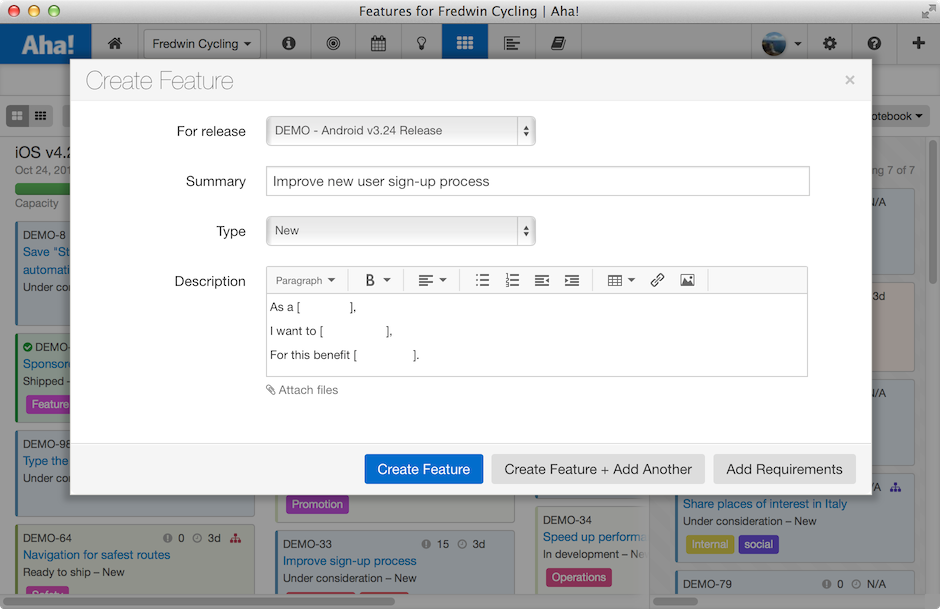
Just Launched! — Add Custom Feature and Requirement Templates
Great products are comprised of great features. Ultimately, a great feature is one that is clearly defined and provides a compelling use case. It contains a concise narrative about the problem the feature solves, how it will be used, and the benefit it provides.
Yes, I am talking about the most fundamental building blocks of products: features and requirements. You might call them stories.
First, a little background information might help. Features (or user stories) are short, simple descriptions of a new capability. Historically, they simply defined what the technology should do. Today, they are often presented from the perspective of the value the new functionality will deliver to an end user. The feature typically has a high level description and detailed requirements to help define what it should do.
Some teams prefer to describe features in free form text and others prefer to keep them consistent and use a template.
If you use an agile methodology, you might be familiar with casting your stories from the perspective of a user. You may use a template like this for all of your requirements.
As a (type of user), I want (to perform some task) so that I can (achieve some goal).
That’s why today we are launching an important feature in Aha! that many of you have asked for. You can now specify a template for the description of a feature or requirement to drive consistency in how features are defined. You can create these templates under Feature Workflow in Account Settings (more on this later).
Now each new feature and requirement in Aha! will have a consistent set of details when it is created by someone on your team.
The template you create will pre-fill every time a new record is created. Creating consistent features in Aha! is now as easy as clicking the (+) button and selecting Feature from the drop-down menu.

You can add templates for Features and Requirements in Aha! — here’s how it works for each one:
Templates for features
You can create templates for all of your feature types, including new features, improvements, bugs and even new types that you create. And for each one, you can customize the template that is used. Once you add a template, every time a new record is created, a user is guided to enter the information that is relevant for that type of feature. The example below shows an agile-centric template.

Reminder: You have the ability to adjust the terminology used in Aha! to match the language your team uses. For example you could rename “Features” to “User Stories.”
Templates for requirements
Similar to features, each team uses requirements differently. Some teams use requirements to capture multiple details, while others create a separate requirement for each new detail.
Requirement templates are edited right below the feature template under Feature Workflow in Account Settings. It gives you the ability to automatically insert text into each newly created requirement for a given workflow.
For example, a product owner might create the following requirement template to ensure that requirements are focused on a single concept and do not get bloated.

Configuration
To get started, find the Configure status, workflows, and feature types section in Account Settings and click on an existing workflow or use the +Add Feature Workflow and Types button.

Next, find the Custom Types section at the bottom of the page and click on an existing Type name or +Add Type.

Finally, enter the text you would like to use for that feature and requirement template. You can add a different template for each type.
Now when a user creates a new Feature, the text box will allow a user to specify which template shows up in the description field. It’s worth mentioning that the templates are meant to be a guide. The user can edit the text if they want.
Using feature templates ensures features and requirements are clearly defined from the start, and engineering has everything they need to build exactly what you need.
Thanks to those of you who suggested this idea in our ideas portal.
Hopefully, your job just got a little bit easier.
Signup for a free Aha! trial — be happy Feature and requirement templates are available to all Aha! customers. If you are not already an Aha! customer, you may want to sign up for a free 30-day trial of Aha! now to see why over 20,000 users trust Aha! to set product strategy, create visual roadmaps, and prioritize releases and features.
